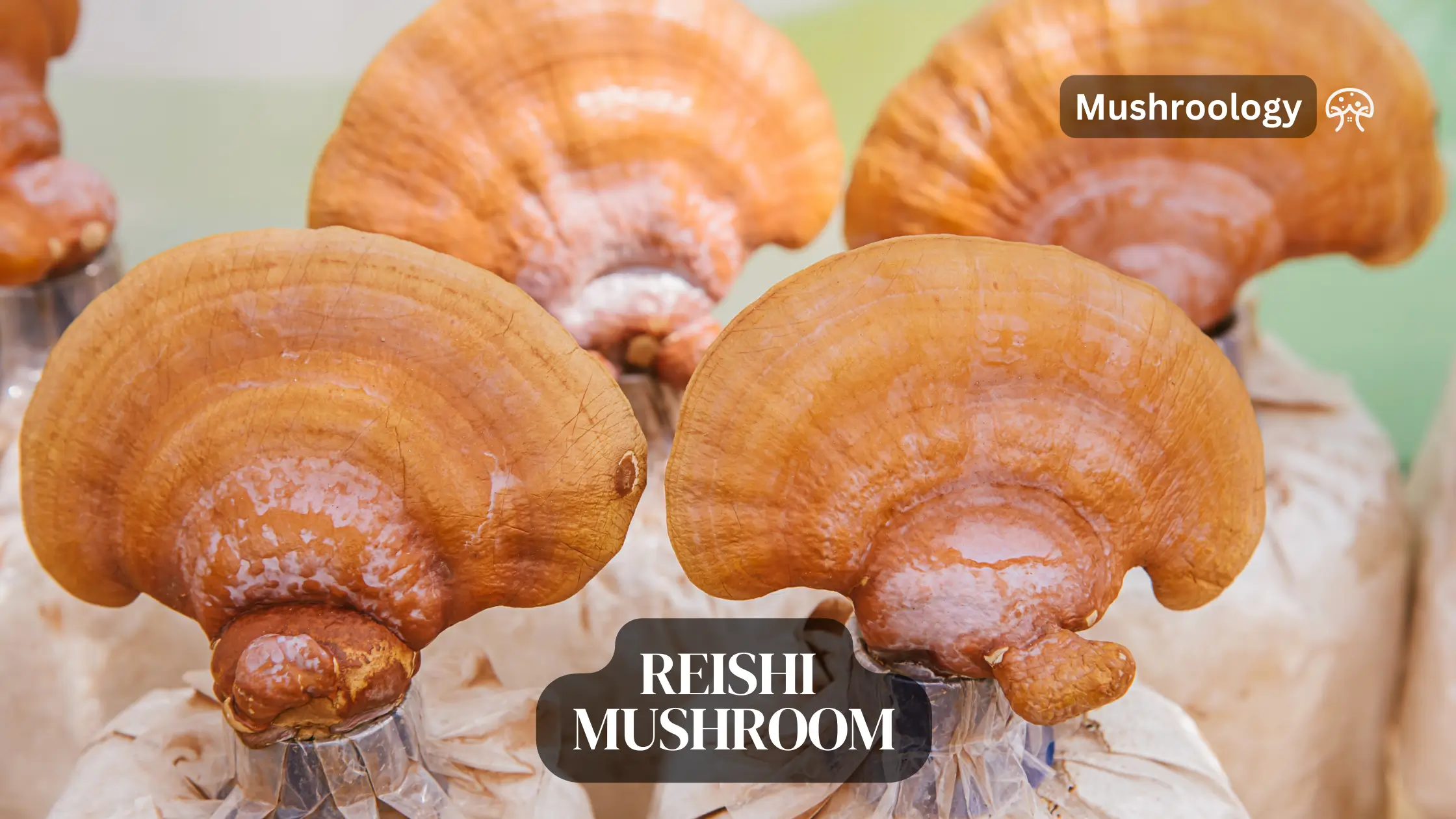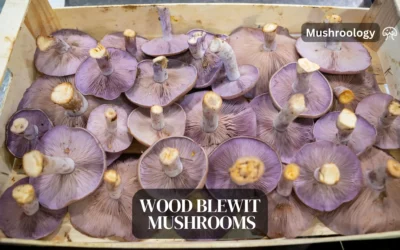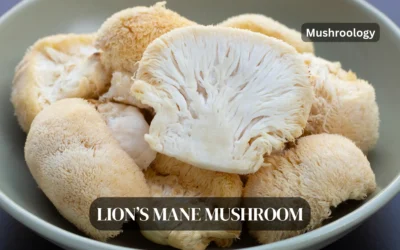Ganoderma lucidum, known as Reishi mushrooms in the West and Lingzhi in Eastern cultures, is a medicinal mushroom species with a rich history of use for its health-promoting properties. Revered for over 2000 years, particularly in Asia, Reishi is often referred to as the “mushroom of immortality” due to its purported longevity benefits.
what are Reishi Mushrooms?
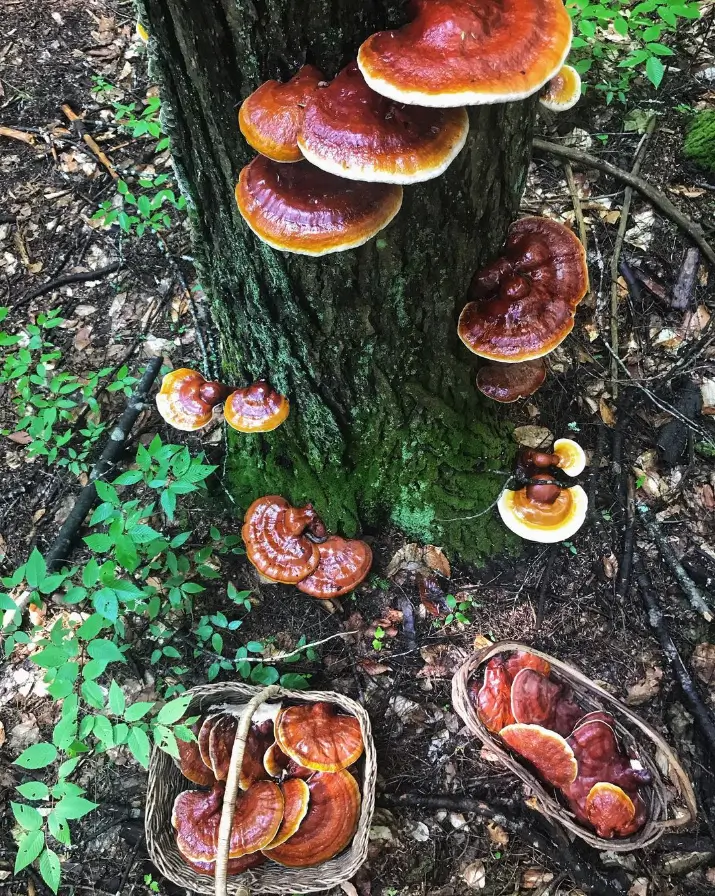
Reishi mushrooms are a type of bracket or shelf fungus, which means they grow horizontally, typically out of hardwood stumps and trees. They start as “antlers” or slender stalks, deep red to rust-brown with lighter tips. As they mature, they develop into a fan shape with a distinctive shiny, varnished appearance that ranges from deep red to orange.
There are approximately 80 species of Ganoderma lucidum worldwide, each with its own unique characteristics and growing requirements. Some species, like Ganoderma tsugae, prefer coniferous trees, while others thrive on deciduous hardwoods such as maple or oak. Reishi’s adaptability allows it to grow in various climates, from tropical to temperate regions.
Cultivation methods for Reishi Mushrooms
Reishi can be cultivated both indoors and outdoors using different methods. Indoors, growers can use sawdust blocks or bags, while outdoors, logs or stumps can be inoculated with Reishi spawn. The choice of method depends on the grower’s experience level and the desired quantity of mushrooms.
Health Benefits and Uses of Reishi Mushrooms
Ganoderma lucidum is considered an adaptogen, which means it may help the body regulate stress. Its adaptogenic properties contribute to its high economic demand. Traditionally, Reishi is not used for culinary purposes due to its woody texture and bitter taste. Instead, it is dried and processed into teas, tinctures, or powders for medicinal use.
Growing Environment
Reishi mushrooms prefer warm and humid conditions, so they thrive in environments that mimic their natural habitat. Whether grown in a greenhouse or outdoors, maintaining the right temperature and humidity levels is crucial for successful cultivation.
Understanding the unique characteristics and requirements of Ganoderma lucidum is the first step in successfully growing these mushrooms at home. With their striking appearance and esteemed medicinal value, Reishi mushrooms offer an intriguing and rewarding cultivation experience for enthusiasts and health-conscious growers alike.
Gathering Supplies for Growing Ganoderma Lucidum (Reishi Mushrooms)
Embarking on growing Ganoderma lucidum at home requires assembling the right toolkit. Here’s a detailed breakdown of the essential supplies you’ll need to cultivate Reishi mushrooms successfully.
1. Spores or Spawn
The foundation of mushroom cultivation starts with high-quality spores or spawn. For beginners, purchasing ready-to-inoculate spawn from a reputable supplier is the most straightforward approach. This can come as grain spawn, sawdust spawn, or even plug spawn for log cultivation.
2. Substrate
Reishi mushrooms thrive on a substrate of hardwood sawdust mixed with a supplemental grain such as wheat bran. This combination provides the necessary nutrients for the mushrooms to grow. A common ratio is 80% hardwood sawdust to 20% grain by weight.
3. Bags or Containers
For indoor cultivation, autoclavable bags with filter patches are ideal for sterilizing and incubating the substrate. These bags allow for gas exchange while preventing contamination. Alternatively, reusable containers with tight-fitting lids can also be used, provided they can withstand sterilization temperatures.
4. Sterilization Equipment
A pressure cooker or autoclave is essential for sterilizing the substrate and equipment. Sterilization kills any potential contaminants, ensuring a clean environment for the Reishi mushrooms to grow. The substrate should be sterilized at 121°C (250°F) for at least 90 minutes.
5. Incubation Space
A dark, warm area is required for the incubation phase. The ideal temperature range for Reishi mushroom mycelium to colonize the substrate is between 24-28°C (75-82°F). This space doesn’t need to be large but should be consistent in temperature and free from drafts.
6. Fruiting Environment
After colonization, the mushrooms must be exposed to fresh air, higher humidity (85-90%), and indirect light to initiate fruiting. This can be achieved in a greenhouse, a humidity tent, or a modified indoor space. Monitoring and adjusting the environment are crucial for successful fruiting.
7. Harvesting Tools
A sharp knife or scalpel is necessary for harvesting Reishi mushrooms. Due to their woody texture, a sturdy tool is required to cut them from the substrate.
8. Drying and Storage Materials
After harvesting, Reishi mushrooms need to be dried for long-term storage. A food dehydrator set at a low temperature works well for this purpose. Once dried, the mushrooms should be stored in an airtight container in a cool, dark place.
Gathering these supplies is the first practical step in your Reishi mushroom cultivation journey. Each component plays a vital role in the process, from starting with quality spawn to creating the ideal growth conditions and harvesting and preserving your mushrooms. With the right tools and materials at hand, you’re well on your way to growing Ganoderma lucidum at home.
Preparing the Substrate for Ganoderma Lucidum (Reishi Mushrooms)
The substrate preparation is a critical step in the cultivation of Ganoderma lucidum, as it provides the essential nutrients and environment for the mushrooms to grow.
Ingredients and Ratios
For a 5 lb (2.3 kg) block of substrate, you will need:
- Five cups of hardwood pellets
- One and a quarter cups of bran (wheat or rice bran)
- Six cups of water
Hardwood pellets serve as the primary component of the substrate, providing the cellulose-rich material that Reishi mushrooms prefer. The bran acts as a supplemental nutrient source, enhancing mycelial growth.
Substrate Preparation Process
- Soaking the Pellets: Combine the hardwood pellets with water in a bucket or bowl. Allow them to soak for 30 minutes, which will cause the pellets to break apart and turn into sawdust. Using warm water can speed up this process, although it’s not strictly necessary.
- Adding the Bran: After the pellets have fully broken down into sawdust, add the bran and mix thoroughly until it’s evenly distributed throughout the sawdust. This mixture now forms your base substrate.
- Moisture Content Check: Conduct a squeeze test to ensure the substrate has the correct moisture content. When you squeeze the substrate lightly, it should hold together in your hand, and only a couple of drops of water should come out. The ideal moisture content for Reishi substrate is around 65%.
- Bagging the Substrate: Place the prepared substrate into grow bags, expelling as much air as possible before sealing. For those using containers, ensure they’re filled and sealed properly. This step is crucial for maintaining the substrate’s moisture and nutrient integrity during sterilization.
- Sterilization: Sterilize the substrate by placing the bags or containers in a pressure cooker or autoclave. The substrate should be cooked at 121°C (250°F) and 15 lb pressure for 60-90 minutes. This process eliminates any potential contaminants, creating a sterile environment for the Reishi spores or spawn.
- Cooling: After sterilization, allow the substrate to cool to room temperature before proceeding to inoculation. This cooling process can take up to eight hours. It’s essential to ensure the substrate is completely cool to prevent killing the mushroom spawn upon inoculation.
Additional Tips
- Local Substrates: Depending on availability, local substrates like rice bran can be used as a supplement. Experimenting with different locally available substrates might yield interesting results in terms of growth rates and mushroom yield.
- Nutrient Additives: Some growers add gypsum or calcium carbonate to the substrate mixture to balance pH and provide additional nutrients. While not strictly necessary, these additives can enhance mycelial growth and potentially increase yields.
By carefully preparing the substrate according to these steps, you create a conducive environment for Ganoderma lucidum to thrive. The quality of the substrate plays a significant role in the success of your Reishi mushroom cultivation, making this step one of the most important in the entire process.
Inoculation of Ganoderma Lucidum (Reishi Mushrooms)
Inoculation is a pivotal step in the cultivation of Ganoderma lucidum, where the prepared substrate is introduced to the mushroom spawn. This process sets the stage for the growth of Reishi mushrooms by establishing the mycelium, the vegetative part of the fungus, within the substrate.
Choosing the Inoculation Method
The method of inoculation can significantly impact the growth and biomass production of Ganoderma lucidum. Three primary methods are commonly used:
- Mycelial Disks: This involves using small pieces of mycelium grown on a nutrient-rich medium, such as potato dextrose agar (PDA), and transferring them to the substrate.
- Spore Suspension: A suspension of spores is prepared in sterile water and then introduced to the substrate. This method requires careful handling to ensure the spores are evenly distributed.
- Pre-inoculation (Grain Spawn): Pre-inoculated grain spawn, where the mycelium has already begun to grow on grains such as rye or wheat, is mixed into the substrate. This method is noted for producing more homogeneous growth and better distribution of the mycelium within the substrate.
Inoculation Steps
- Preparation: Ensure the substrate is at room temperature and the workspace is clean to minimize contamination risk.
- Introduction of Spawn: Depending on the chosen method, introduce the mycelial disks, spore suspension, or grain spawn to the substrate. For grain spawn, evenly mix the spawn with the substrate to ensure good mycelial spread.
- Sealing: If using bags, seal them with a filter patch to allow for gas exchange while preventing contamination. Containers should be closed with a lid that allows some air exchange.
- Labeling: Mark the inoculated substrate with the date and type of mushroom for future reference. This helps in monitoring the growth and identifying any issues that may arise during the cultivation process.
Environmental Conditions for Inoculation
After inoculation, the substrate needs to be kept in a dark, warm place with a temperature between 24-28°C (75-82°F) to encourage mycelial growth. The environment should be stable without drastic temperature fluctuations to avoid stressing the developing mycelium.
Monitoring and Adjustments
- Growth Observation: Check the substrate regularly for signs of mycelial growth. White, web-like structures should start to appear, indicating successful colonization.
- Moisture Management: Ensure the substrate maintains its moisture content without becoming waterlogged. Adjust environmental humidity if necessary.
Troubleshooting
- Contamination: If contamination is observed (unusual colors or smells), the affected part of the substrate should be removed immediately to prevent it from spreading.
- Slow Growth: Check the temperature and moisture levels if mycelial growth is slower than expected. Adjustments may be needed to provide optimal conditions for growth.
Inoculating Ganoderma lucidum requires careful attention to detail and cleanliness to ensure successful mycelium colonization. By selecting the appropriate inoculation method and maintaining the right environmental conditions, cultivators can set the stage for a fruitful Reishi mushroom harvest.
Incubation of Ganoderma Lucidum (Reishi Mushrooms)
After inoculation, the Reishi mushroom substrate enters the incubation phase, a critical period where the mycelium colonizes the substrate. Proper incubation is essential for developing a healthy and robust mycelial network, which is the foundation for successful fruiting.
Incubation Conditions
The ideal conditions for incubating Reishi mushroom substrate are:
- Temperature: Maintain a consistent temperature between 24-28°C (75-82°F). Some temperature fluctuation is tolerable, but extremes can be detrimental to mycelial growth.
- Humidity: While the substrate should have the correct moisture content, the surrounding humidity doesn’t need to be as high during this phase. However, it should not be so low as to dry out the substrate.
- Darkness: Reishi mycelium grows best in the dark, so incubation should occur in a dark space or the bags should be kept away from direct light.
- Air Exchange: Minimal air exchange is needed during this phase, but the environment should not be completely airtight. Bags with filter patches or containers with small air holes can provide the necessary gas exchange.
Duration of Incubation
The incubation period for Reishi mushrooms typically lasts between 14-21 days, but it can take longer depending on the environmental conditions and the vigor of the mycelium. Full colonization is indicated by a dense, white mycelial network encompassing the substrate.
Monitoring Mycelial Growth
Regularly inspect the substrate for signs of mycelial growth without opening the bags or containers, as this can introduce contaminants. Look for a white or off-white network of fibers spreading throughout the substrate. If colonization is uneven or stalled, assess and adjust the temperature and moisture levels as needed.
Troubleshooting During Incubation
- Contamination: Be vigilant for any signs of contamination, such as green, black, or orange spots (mold), or a sour or ammonia-like smell. Contaminated bags should be removed from the incubation area immediately to prevent the spread of contaminants.
- Overheating: If the incubation area is too warm, it can lead to overheating and potentially kill the mycelium. Ensure the temperature is monitored and controlled.
- Drying Out: If the substrate appears to be drying out, it may be necessary to increase the humidity of the incubation area or check for leaks in the bags or containers.
Transitioning to Fruiting
Once the substrate is fully colonized, it’s time to transition to the fruiting phase. This involves changing the environmental conditions to trigger the Reishi mushrooms to produce fruit bodies. The substrate will be exposed to fresh air, higher humidity, and indirect light to initiate this next stage of growth.
The incubation phase is a time of anticipation and care, where the groundwork laid during substrate preparation and inoculation comes to fruition. By maintaining the proper conditions and monitoring the growth, cultivators can ensure a strong mycelial foundation for the subsequent fruiting of Ganoderma lucidum.
Fruiting of Ganoderma Lucidum (Reishi Mushrooms)
In the fruiting phase, the mycelium of Ganoderma lucidum transitions into producing the actual mushrooms. This stage requires specific changes in the environment to signal the mycelium that it’s time to form fruiting bodies.
Creating Fruiting Conditions
Once the substrate is fully colonized, the environmental conditions need to be adjusted to initiate fruiting:
- Temperature: Lower the temperature slightly to 22-25°C (71-77°F) to simulate a natural change in the environment that encourages fruiting.
- Humidity: Increase the humidity to 85-90% to provide the moisture necessary for mushroom development.
- Fresh Air: Introduce fresh air to the growing area to increase the oxygen level, which is a critical trigger for mushroom formation.
- Light: Expose the substrate to indirect light, which is another signal for the mushrooms to start fruiting. Reishi does not require strong light, so ambient room light or a few hours of indirect sunlight is sufficient.
Antler Formation and Bracket Development
During the early stages of fruiting, Reishi mushrooms will form structures known as “antlers,” which are elongated, finger-like projections. If the growing environment has a high CO2 concentration and limited fresh air, these antlers will continue to elongate. However, if fresh air is abundant, the antlers will stop elongating and start to form “brackets” or “conks,” which are the flat, fan-shaped fruiting bodies characteristic of Reishi mushrooms.
Managing the Fruiting Environment
- Air Exchange: Ensure there is enough air exchange to maintain oxygen levels without drying out the mushrooms. This can be done by making small openings in the fruiting chamber or by fanning the air manually.
- Humidity Control: Use a humidity tent or mist the air around the mushrooms to maintain high humidity. A shallow pan of water in the growing area can also help maintain humidity levels.
- Watering: If the substrate begins to dry out, gently mist it with water. Be careful not to overwater, as this can lead to mold growth.
Monitoring Mushroom Development
As the Reishi mushrooms develop, they will go through several stages:
- Antler Stage: The initial growth stage where the mushrooms are elongated and have a bright white edge.
- Bracket Stage: As the mushrooms mature, they will flatten out and take on the classic Reishi shape. The edges will turn from white to orange and finally to red, indicating that they are nearing maturity.
Harvesting Indicators
The best time to harvest Reishi mushrooms is just before they release their spores. This is typically when the white edge of the mushroom has disappeared, and the entire mushroom has taken on a reddish color with a shiny, varnished appearance. The spores are a fine brown powder that the mushrooms will release as they mature, so it’s best to harvest before this occurs to avoid a mess and potential respiratory irritation.
Troubleshooting Fruiting Issues
- Poor Fruiting: Check the humidity and fresh air levels if the mushrooms are not developing well. Adjusting these can often resolve fruiting issues.
- Mold or Contamination: If you notice mold or other contaminants, increase air exchange and remove any affected mushrooms to prevent the spread.
Cultivators can encourage the growth of healthy, potent fruiting bodies by carefully managing the fruiting conditions and monitoring the development of the Reishi mushrooms. This phase requires patience, as Reishi mushrooms are slow-growing and can take several months to reach maturity.
How to harvesting and store Ganoderma Lucidum (Reishi Mushrooms)
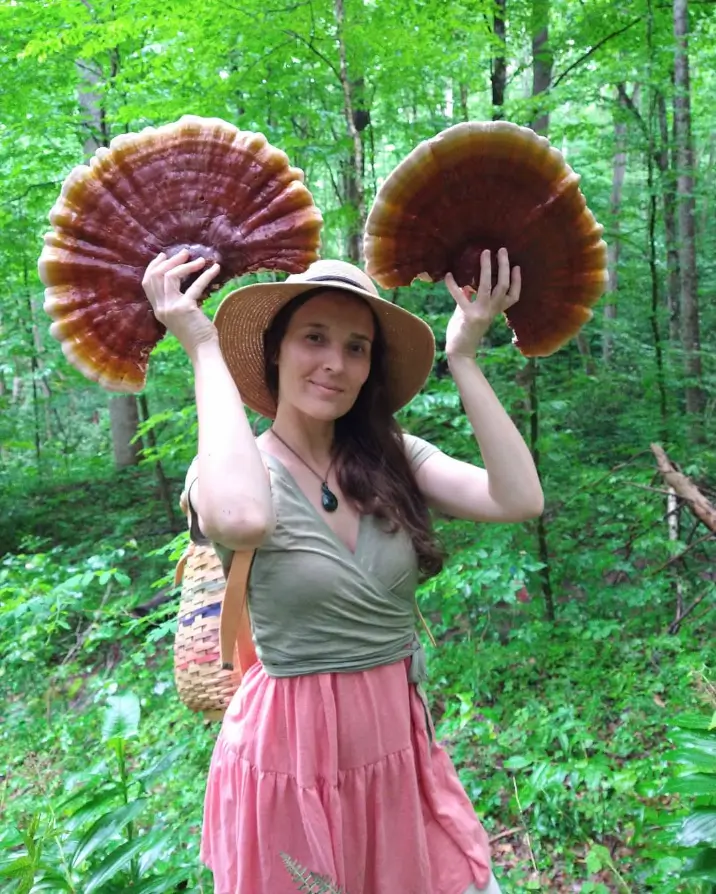
Harvesting Reishi mushrooms at the right time and storing them properly is crucial to preserving their medicinal properties.
When to Harvest Reishi Mushrooms
Reishi mushrooms can be harvested at various stages of growth, but for optimal medicinal quality, it’s best to harvest just before they release their spores. The indicators for the right harvesting time are:
- The mushroom’s edges have turned from white to red, indicating maturity.
- The underside of the mushroom may show a brown color from spore production.
- The mushroom has stopped growing and the shiny, varnished surface is fully developed.
Harvesting Technique
To harvest Reishi mushrooms:
- Use a sharp pair of scissors or a knife to cut the mushrooms at the base, close to the substrate or log.
- Handle the mushrooms gently to avoid damaging the fruiting body and to prevent spore dispersal in your growing area.
Fresh Storage
Fresh Reishi mushrooms can be stored in the refrigerator for up to four weeks. It’s recommended to use a breathable container, such as a folded brown paper bag, to reduce condensation and prevent the mushrooms from becoming too wet, which can shorten their shelf life.
Drying Reishi Mushrooms
For long-term storage, drying is the best method:
- Chop the fresh Reishi into smaller pieces immediately after harvesting to facilitate drying.
- Use a food dehydrator set at a low temperature or air-dry in a well-ventilated area away from direct sunlight.
- Once completely dry, store the Reishi pieces in an airtight container, preferably glass, in a cool, dark place. Adding a desiccant pack can help keep moisture out.
Freezing Reishi Mushrooms
While freezing is technically possible and can preserve the mushrooms’ medicinal properties, drying is generally preferred due to ease and space considerations.
Post-Harvest Tips
- Avoid washing the mushrooms as they are difficult to dry once wet.
- If harvesting from the wild or your garden, never take more than what you need, leaving some to continue their natural cycle.
- After harvesting, clean up any loose spores to prevent inhalation, which can be a health hazard.
By following these harvesting and storage guidelines, you can ensure that your Ganoderma lucidum mushrooms retain their medicinal qualities for use in teas, tinctures, and other preparations. Whether you’re storing them for a few weeks in the fridge or drying them for long-term use, proper handling is key to maintaining their potency.
Troubleshooting Common Issues in Ganoderma Lucidum Cultivation
Growing Ganoderma lucidum, or Reishi mushrooms, can be rewarding, but cultivators may encounter several common issues. Understanding how to address these problems is crucial for a successful cultivation experience.
Contamination
- Problem: Contamination is often seen as mold or off-color growth on the substrate, which can occur if the cultivation area or tools are not sterile.
- Solution: To prevent contamination, ensure all equipment and the cultivation area are thoroughly sterilized. If contamination occurs, remove and discard the affected parts immediately to prevent spread.
Poor Mycelium Growth
- Problem: Slow or nonexistent mycelium growth can be due to inadequate temperature, incorrect substrate preparation, or poor-quality spores.
- Solution: Double-check the temperature, substrate preparation, and spore quality. Adjust the temperature and humidity levels as needed to stay within the ideal range, and ensure the substrate is properly prepared and moist.
Inadequate Fruiting
- Problem: Reishi mushrooms may not fruit as expected if the environmental conditions aren’t ideal.
- Solution: Review and adjust the humidity, temperature, and light conditions. Ensure that the fruiting area has sufficient fresh air exchange and that the humidity is maintained between 85-90%.
Pest Infestations
- Problem: Pests such as flies, spiders, aphids, termites, ants, and stem borers can damage or contaminate the fruiting bodies.
- Solution: Keep the cultivation area clean and free of debris where pests can breed. Use physical barriers like insect nets and consider using natural repellents like incense to deter flies and mosquitoes.
Environmental Fluctuations
- Problem: Fluctuations in temperature and humidity can stress the mycelium and affect mushroom growth.
- Solution: Monitor the environment closely and use tools like thermostats and hygrometers to maintain stable conditions. Make adjustments to heating, cooling, or humidification systems as necessary.
Mushroom Morphology Issues
- Problem: High CO2 levels or insufficient light can cause mushrooms to develop long stems and small caps, or to form in the shape of deer horns.
- Solution: Increase ventilation in the growing area to reduce CO2 levels and ensure there is enough indirect light for the mushrooms to develop normally.
Mold and Bacterial Infections
- Problem: The fruiting body may become soft, rotten, or slimy due to high humidity or bacterial infections.
- Solution: Adjust the humidity if it’s too high and ensure proper air circulation. Remove any infected mushrooms to prevent the spread of bacteria or mold.
Watering and Moisture Control
- Problem: Over-watering can lead to mold growth, while under-watering can dry out the substrate and halt mycelium growth.
- Solution: Mist the growing area regularly to maintain high humidity but avoid over-watering. The substrate should be moist but not saturated.
By anticipating these common problems and preparing solutions, you can increase your chances of a fruitful Reishi mushroom harvest. Regular attention and adjustments based on the mushrooms’ growth and environmental changes are crucial for successful cultivation.

